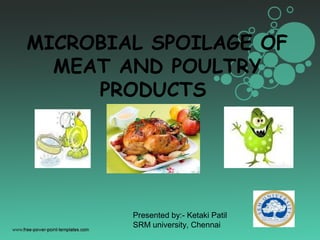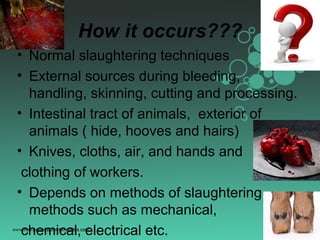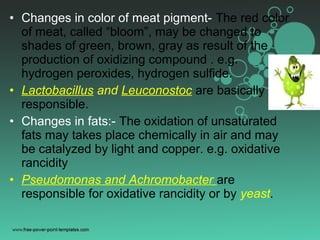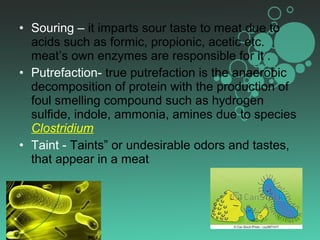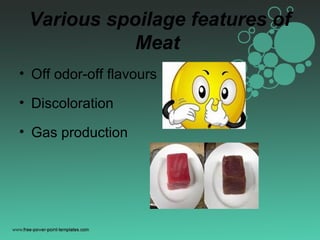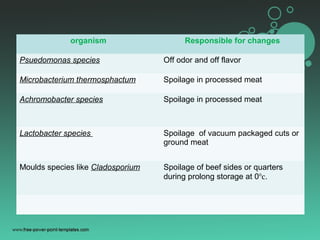Spoilage of meat
- 2. MICROBIAL SPOILAGE OF MEAT AND POULTRY PRODUCTS Presented by:- Ketaki Patil SRM university, Chennai
- 3. What is Spoilage??? âĒ Spoilage is the process in which food deteriorates to the point in which it is not edible to humans or its quality of edibility becomes reduced.
- 4. What is microbial spoilage??? âĒ Microbes can be responsible for the spoilage of food. When they breaks down the food, acids and other waste products are created in the process. While the microbes itself may or may not be harmful, the waste products may be unpleasant to taste or may even be harmful to one's health
- 5. How it occurs??? âĒ Normal slaughtering techniques âĒ External sources during bleeding, handling, skinning, cutting and processing. âĒ Intestinal tract of animals, exterior of animals ( hide, hooves and hairs) âĒ Knives, cloths, air, and hands and clothing of workers. âĒ Depends on methods of slaughtering methods such as mechanical, chemical, electrical etc.
- 6. MEAT SPOILAGE âĒ Raw meat is subject to change by its own enzymes and microbial action and its fat may be oxidized chemically. âĒ Autolysis changes include some proteolytic action on muscle and connective tissue and slight hydrolysis of fats. âĒ The defect caused by excessive autolysis has been called âsouringâ
- 7. Invasion of tissue by micro organism âĒ Upon the death of the animal, invasion of tissue by contaminating micro organism takes place. âĒ Factors influence that invasion includes following:- âĒ The load in the gut of the animal âĒ The physical condition of the animal immediately before slaughter âĒ The method of killing and bleeding âĒ The rate of cooling
- 8. Growth of micro organism in Meat âĒ Meat is an ideal culture for many microbes because it is high in moisture, rich in nitrogenous foods of various degree of complexity , and plentifully supplied with minerals and accessory growth factors. âĒ Also, it usually has some fermentable carbohydrate( glycogen) & is at favorable pH for most micro-organism.
- 9. Factors influence growth of microorganism âĒ The kind & amount of contamination with microorganism and the spread of these microorganism in the meat. âĒ The physical properties of the meat âĒ Chemical properties of the meat âĒ Availability of oxygen âĒ Temperature
- 10. Types of Spoilage of Meats âĒ Spoilage under 1)Aerobic conditions 2)anaerobic conditions
- 11. Spoilage under Aerobic conditions âĒ Under aerobic conditions bacteria may cause the following- âĒ Surface slime â which may be caused by species of Pseudomonas, Acinetobacter, Moraxella, Alcaligenes, streptococcus, Leuconostoc, Bacillus, and Micrococcus âĒ It is early indication of spoilage, often observed before expiry date.
- 12. âĒ Changes in color of meat pigment- The red color of meat, called âbloomâ, may be changed to shades of green, brown, gray as result of the production of oxidizing compound . e.g. hydrogen peroxides, hydrogen sulfide. âĒ Lactobacillus and Leuconostoc are basically responsible. âĒ Changes in fats:- The oxidation of unsaturated fats may takes place chemically in air and may be catalyzed by light and copper. e.g. oxidative rancidity âĒ Pseudomonas and Achromobacter are responsible for oxidative rancidity or by yeast.
- 13. âĒ Phosphorescence â This rather uncommon defect caused by phosphorescent or luminous bacteria. E.g. Photobacterium spp. Grows on the surface of meat. âĒ Various surface colours due to pigmented bacteria:- red spot may be caused by Serratia marcescens or other bacteria with red pigment. Pseudomonas syncyanea can impart blue color to the surface, Micrococcus or flavobacterium imparts yellow color with yellow pigment and Chromobacterium lividum and other bacteria gives greenish blue or brownish black spot.
- 14. âĒ Off odors and off taste:- âTaintsâ or undesirable odors and tastes, that appear in a meat . â souringâ is the term applied to almost any defect that gives the sour odor that may be due to volatile acids. e.g. formic, butyric,propionic acids âĒ âCold storage flavorâ or taint its nothing but stale flavor. âĒ Actinomycetes may be responsible for Musty or earthy flavor
- 15. Aerobic growth of moulds may causes âĒ Stickiness â surface becomes sticky âĒ Whiskers- when meat is stored at temperatures near freezing, a limited amount of mycelial growth may takes place without sporulation. âĒ Black spot- this usually caused by Cladosporium herbarum âĒ White spot- Sporotricum carnis mostly causes white spots.
- 16. âĒ Green patches- this occurs due to species Penicillum such as p.expansum P.oxalicum âĒ Decomposition of fats- many molds have lipase and hence cause hydrolysis of fats .
- 17. Spoilage under anaerobic conditions âĒ Facultative and anaerobic bacteria can able to grow within the meat under anaerobic conditions and cause spoilage. âĒ Following changes occurs in such conditions âĒ Souring âĒ Putrefacation âĒ Taint
- 18. âĒ Souring â it imparts sour taste to meat due to acids such as formic, propionic, acetic etc. meatâs own enzymes are responsible for it . âĒ Putrefaction- true putrefaction is the anaerobic decomposition of protein with the production of foul smelling compound such as hydrogen sulfide, indole, ammonia, amines due to species Clostridium âĒ Taint - Taintsâ or undesirable odors and tastes, that appear in a meat
- 19. Various spoilage features of Meat âĒ Off odor-off flavours âĒ Discoloration âĒ Gas production
- 20. Off âodors & off flavours âĒ Off odors such as sweet and fruity, putrid, sulphury and cheesy, are characterized in aerobically stored meat. âĒ Species which are responsible Psuedomonas sp. & Psuedomonas fragi âĒ Sulphur compounds may also contribute off flavor
- 21. Discoloration âĒ The bacterial production of hydrogen sulphide converts the muscle pigment to green sulphmyoglobin. âĒ Hydrogen sulphide is produced from cystein and is triggered by glucose limitation L.sake forms hydrogen sulphide.
- 22. Gas production âĒ Clostridium spp. have been associated with the production of large amount of gas in vacuum packaged beef , accompanied by foul off-odors. Gas production (co2) by lactic acid bacteria without extensive off odors may be associated with vacuum packaged beef and pork.
- 23. organism Responsible for changes Psuedomonas species Off odor and off flavor Microbacterium thermosphactum Spoilage in processed meat Achromobacter species Spoilage in processed meat Lactobacter species Spoilage of vacuum packaged cuts or ground meat Moulds species like Cladosporium Spoilage of beef sides or quarters during prolong storage at 0°c.
- 24. Cured meat type Spoilage organism Sliced ham and bacon Souring due to Streptococcus faecium, & Microbacterium thermosphactum Pasteurized canned product Bacillus sps., clostridium sps.,enterococci, streptococci and heat resistance lactic acid bacteria Refrigerated canned product Streptococcus sps.
- 25. Type of sausage Type of spoilage Organism responsible Fresh uncooked sausage Putrefaction souring Achromobacter and Psuedomonas & Microbacterium thermosphactum, Cooked sausages Irregular green spots on surface, green cores Narrow green rings within the product Lactobacteriaceae, Leuconostoc, streptococci and pediococci Cooked sausages sliming Yeast , Microbacterium thermosphactum
- 26. References âĒ Willam C. Frazier Food microbiology âĒ Principles Of Meat Technology by V.P Singh âĒ Food microbiology by K. Vijaya Ramesh


